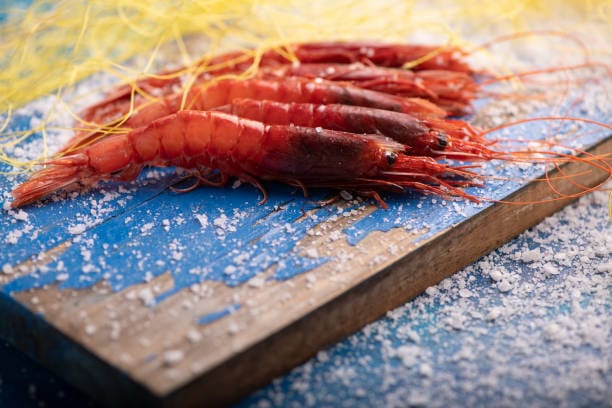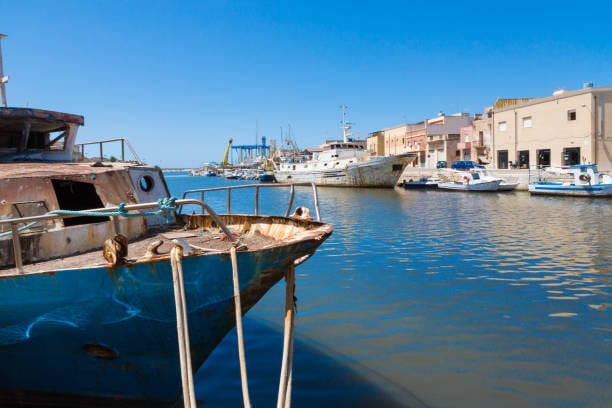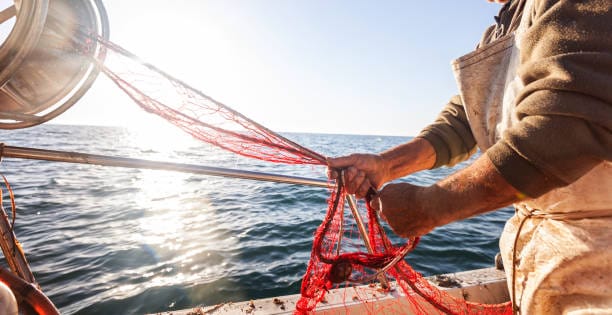
Whether it’s the Gambero Rosso of Sicily, Carabineros of Spain or the Aka Ebi of Japan, red prawns have earned their reputation as a luxury ingredient. Red Prawns are among the ocean’s most prized delicacies, instantly recognisable by their vibrant crimson shells and celebrated for their rich, sweet flavour and melt-in-the-mouth texture. Found in deep waters across the Mediterranean, Atlantic, and parts of the Pacific, these crustaceans are beloved by chefs and gourmets alike for their remarkable depth of taste and culinary versatility.
Gambero Rosso (Aristaeomorpha foliacea)
Gambero Rosso offers a truly luxurious flavour experience that sets it apart from any other shellfish. Its taste is refined and delicate, yet deeply expressive of the sea. The flesh is naturally sweet, not sugary, but rather a soft, elegant sweetness that evokes fresh shellfish at their peak. This sweetness is especially prominent in the tail, where the texture is silky and buttery, almost sashimi-like when eaten raw. It carries a clean marine essence with no harsh iodine or fishy aftertaste, only a refreshing, mineral note that lingers softly on the palate.
What truly defines the flavour, however, is the head. Inside lies a creamy, coral-colored tomalley — rich, savoury, and full of umami. It offers a burst of ocean depth, reminiscent of lobster bisque or crab butter, with a luxurious mouthfeel that chefs treasure. Pressed over crudo or stirred into pasta, it adds complexity, salinity, and an unmistakable signature of the deep Mediterranean.
When lightly cooked, the Gambero Rosso develops an almost nutty warmth. Grilling or searing briefly caramelises the outer shell and brings out subtle roasted notes without masking its natural sweetness. The aroma is floral and marine at the same time — gentle, clean, and elegant, like sea breeze infused with something faintly creamy. The overall effect is one of balance and softness, with each element, sweet, salty, and umami, in perfect harmony.
This is a prawn that doesn’t shout. It whispers complexity, inviting attention rather than demanding it. Whether raw, barely cooked, or used in a refined broth, Gambero Rosso delivers a flavour that’s deep, lingering, and unmistakably Sicilian.
Gambero Rosso translates to “red prawn” in Italian and typically refers to the deep-water red prawn found in the Mediterranean Sea, especially around Mazara del Vallo, a fishing town on the southern coast of Sicily.

Habitat and biology
The Gambero Rosso, also known as the Mediterranean red prawn or deep-water rose shrimp, inhabits deep marine environments, typically at depths ranging from 200 to 1000 meters, though it can sometimes be found as deep as 1300 meters. It prefers muddy or sandy-muddy seabeds and thrives in cold, stable temperatures with very little to no natural light.
This prawn is most famously found in the central Mediterranean, particularly in the Sicilian Channel near Mazara del Vallo, an area known for the high quality and abundance of this species. Beyond the Mediterranean, it is also present in the eastern Atlantic Ocean, from southern Portugal down to the coasts of West Africa and Cape Verde, as well as in some parts of the Indian Ocean and western Pacific, though the Mediterranean variety is especially prized in gastronomy.
Biologically, Aristaeomorpha foliacea belongs to the Aristeidae family of deep-sea prawns. It is characterised by its vivid red colouration, which serves as a form of camouflage in the deep sea, where red light doesn’t penetrate and the colour appears almost black. These prawns can grow up to 25 centimetres in length, though most commonly reach around 15 to 18 centimetres.
They are carnivorous scavengers, feeding on small fish, crustaceans, plankton, and organic debris on the ocean floor. Sexual maturity is typically reached at around two to three years of age. Reproduction usually peaks in spring or early summer, with females carrying fertilised eggs on their pleopods (the swimmerets under their abdomen) until hatching. Their life span can stretch over several years, depending on environmental conditions.

cultural aspect
Mazara del Vallo is a city with a rich Arab-Sicilian heritage, and this cultural fusion is reflected in the way Gambero Rosso is honoured and prepared. Dishes sometimes blend North African spices, Mediterranean herbs, and Sicilian citrus, creating bold, unexpected combinations that reflect centuries of coexistence and exchange.
In homes and restaurants alike, Gambero Rosso is often served on festive occasions, religious holidays, and family gatherings. Its appearance on the table signals something special, a celebration of abundance and care.
In Mazara del Vallo, the heart of the Gambero Rosso world, red prawns are woven into the daily life of the port. For generations, families have passed down the skills of deep-sea fishing, navigating the Mediterranean’s rich waters with intuition, ritual, and respect. The town’s culture is shaped by the rhythms of the sea, and the red prawn is its shining ambassador.
Fishermen often bless their boats before departing and return with their catch as local markets buzz in anticipation. The arrival of fresh Gambero Rosso can feel almost celebratory, a sensory event marked by vibrant colour, salt air, and community pride.

How Gambero Rosso Is Fished
Where It Happens
The Sicilian Channel, south of Mazara del Vallo, is one of the richest fishing zones in the central Mediterranean.
These prawns live at depths of 500 to 1000 meters, where the water is cold, dark, and nutrient-rich, which contributes to their intense flavour and slow growth.
The Fishing Vessels
Most of the red prawns from Mazara are caught by small-to-medium trawlers, often family-owned and passed down through generations.
These boats are equipped with deep-sea trawl nets and onboard freezing systems that immediately flash-freeze the prawns at -50°C to preserve texture and freshness.
A typical vessel can stay at sea for several days, covering wide areas of the deep sea.
Fishing Season
Technically, it is year-round, but the peak season runs from spring through late summer.
To preserve the resource, some boats voluntarily pause during breeding periods or work with co-ops and traceability programs.
Trawling involves dragging a cone-shaped net along the seafloor. It’s extremely effective but must be used responsibly to avoid overfishing and habitat disruption. In Mazara, experienced captains use sonar and mapping technology to minimise environmental impact and target only mature prawns.
As soon as the prawns are pulled up, they are sorted, cleaned, and placed in blast freezers at – 50°C.
This locks in flavour, texture, and colour, making them safe to eat raw even after shipping.
It also allows chefs worldwide to access gambero rosso without sacrificing freshness.

Gambero Rosso & Sustainability
The Good News
- Small-Scale Artisanal Fishing
- Many of the red prawns from Mazara del Vallo are still caught by family-run vessels with deep ties to local ecosystems.
- These fleets are smaller and more selective than industrial ones, reducing overexploitation.
- Flash-Freezing on Board
- This method reduces waste and ensures the catch stays fresh without needing preservatives.
- It also allows precise inventory management — less spoilage = less pressure to overfish.
- Emerging Traceability Systems
- High-end producers like Rosso di Mazara and Don Gambero use full catch-to-plate tracking, often via QR codes or blockchain.
- Consumers can verify:
- Catch date and time
- GPS location
- Depth
- Fishing method
- Vessel identity
- Slow Food & Marine Stewardship Efforts
- Gambero Rosso has been recognised by Slow Food’s Ark of Taste, which promotes endangered ingredients with cultural and ecological value.
- Some boats are now part of pilot projects to reduce seabed damage, lower bycatch, and implement rest periods during breeding seasons.
The Challenges
- Deep-Sea Trawling
- Still the primary method of harvest.
- Can disturb benthic (seafloor) habitats, damage coral or sponge communities, and unintentionally catch non-target species (bycatch).
- It requires high fuel usage, which contributes to emissions.
- Slow Growth & Limited Reproduction
- Gambero Rosso are slow-growing and late to mature, which means they are biologically vulnerable to overfishing.
- Recovery of populations takes longer compared to shallow-water shrimp.
- High Market Demand
- As a gourmet product, prices are high, which can push less ethical practices when regulation is weak.
- Demand from luxury restaurants globally adds pressure on a finite natural resource.
What Can Be Done?
| Action | Benefit |
|---|---|
| Consumer education | Encourages choosing traceable, responsibly caught prawns |
| Catch quotas & licensing | Allows prawns to reproduce and populations to stabilise |
| Seasonal fishing bans | Allows prawns to reproduce and populations to stabilize |
| Fishing gear innovation | Reduces bycatch and seabed damage |
| Aquaculture R&D | Developing closed-loop farms (not yet viable at scale) |
How to Choose Sustainable Gambero Rosso
Buy less but better; quality over quantity.
Look for labels like Traceable Catch Origin, MSC Certification (if available), IQF (Individually Quick Frozen) on board, Producers associated with Slow Food or sustainability initiatives
Support producers who are transparent about: Catch method, Vessel and port, Seasonality